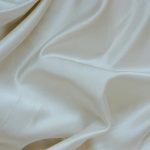If you’re a hot sleeper, linen sheets are your best bet because their open weave and excellent moisture-wicking keep you cooler and drier through the night. Percale also feels cool and crisp but holds more moisture on the surface, making it less effective at cooling you down. Linen softens over time while staying durable, offering lasting comfort. For a deeper look at which fabric best suits your needs and lifestyle, keep exploring their unique qualities and care tips.
Table of Contents
Key Takeaways
- Linen sheets have higher breathability and superior moisture-wicking, making them cooler and better for hot sleepers than percale sheets.
- Percale offers a crisp, smooth feel with moderate breathability but retains more surface moisture, reducing its cooling effectiveness.
- Linen’s open weave quickly pulls moisture away from the body, providing stronger temperature regulation for heavy sweaters.
- Both fabrics soften with washing, but linen maintains better cooling comfort over time due to enhanced moisture management.
- Linen’s cooling benefits outweigh its higher cost, while percale is a budget-friendly option with less effective cooling for hot sleepers.
Understanding Linen Sheets: Material and Texture
Linen sheets come from the flax plant, which gives them a unique texture and breathability you’ll notice right away.
When you touch linen, you’ll feel its slightly rough, natural weave that softens with each wash without losing durability. This texture allows air to flow freely, making linen naturally moisture-wicking and ideal for hot sleepers.
You’ll appreciate how linen’s fibers are thicker and more durable than cotton, giving your sheets a long-lasting quality. Because of their breathability and moisture management, linen sheets keep you cooler and more comfortable throughout the night.
Linen’s thick, durable fibers and breathable nature ensure lasting comfort and coolness all night long.
Plus, their relaxed, slightly wrinkled look adds a casual elegance to your bedroom. You’ll find that linen combines comfort and functionality in a way that’s perfect for warm climates.
Exploring Percale Sheets: Fabric and Weave
While linen offers a natural, breathable feel, percale sheets bring their own cooling benefits through a different fabric and weave.
Percale is typically made from cotton, known for its softness and durability. What sets percale apart is its distinctive weave—a tight, one-over-one-under pattern that creates a matte finish and crisp texture.
This weave makes percale sheets lightweight and smooth, allowing air to circulate more easily around your body. You’ll notice they feel cool to the touch, especially in warmer months.
Because of the tight weave, percale sheets resist pilling and wear well over time. If you prefer a crisp, clean feel without sacrificing breathability, percale sheets offer a great balance between comfort and cooling performance for hot sleepers like you.
Breathability and Moisture-Wicking Properties Compared
Because staying dry and comfortable is key for hot sleepers, understanding how linen and percale handle breathability and moisture-wicking can help you choose the best option. Linen naturally allows air to flow freely and quickly absorbs moisture, making it excellent for hot, sweaty nights. Percale, with its tight weave, is breathable but less absorbent, so it feels crisp but can retain some moisture on the surface.
| Feature | Linen | Percale |
|---|---|---|
| Breathability | High – open weave | Moderate – tight weave |
| Moisture-wicking | Excellent – absorbs quickly | Good – less absorbent |
| Cooling Effect | Strong – keeps you dry | Moderate – crisp feel |
Choose linen if you want maximum airflow and moisture control.
Durability and Care Requirements of Linen and Percale
You’ll want to know how long linen and percale sheets last and what it takes to keep them in good shape.
Proper washing and maintenance can affect their texture and durability over time.
Let’s explore what caring for each fabric involves so you can choose the best fit for your routine.
Fabric Longevity Comparison
Even though both linen and percale sheets offer breathability ideal for hot sleepers, their durability and care requirements differ considerably.
When comparing fabric longevity, you’ll notice these key differences:
- Linen: Extremely durable; it actually gets softer and stronger with each wash, lasting decades if cared for properly.
- Percale: While durable, percale cotton tends to wear out faster than linen, especially under frequent washing and heavy use.
- Care Sensitivity: Linen tolerates rougher handling better, whereas percale requires gentler washing to maintain its crisp feel and prevent thinning.
Choosing between them depends on how much wear you expect and your willingness to meet their care needs.
If longevity is your priority, linen often outperforms percale over time.
Washing and Maintenance Tips
Understanding how to properly wash and maintain your linen or percale sheets plays a big role in preserving their durability and comfort.
For linen, use a gentle cycle with cold or lukewarm water to prevent shrinking. Avoid harsh detergents and bleach—they can weaken fibers. You can tumble dry on low heat but remove sheets while slightly damp to minimize wrinkles.
Percale sheets handle regular machine washing well; use cool or warm water with mild detergent. Avoid fabric softeners, as they reduce breathability. Tumble dry on low and remove promptly to keep the crisp feel.
Both fabrics benefit from occasional air drying to maintain freshness.
Impact of Care on Texture
Although both linen and percale offer breathable comfort, how you care for them directly shapes their texture and longevity.
Linen softens beautifully with each wash, becoming more supple but requires gentle handling to avoid weakening fibers.
Percale feels crisp initially but can lose its smoothness if over-washed or dried improperly.
To keep your sheets in top shape, remember to:
- Wash linen in cool water with mild detergent to preserve strength and softness.
- Use a gentle cycle for percale and avoid high heat drying to maintain its crisp feel.
- Avoid harsh chemicals and excessive agitation, which can damage both fabrics over time.
Comfort and Feel: Which Feels Cooler on Skin?
How do linen and percale sheets feel against your skin when the temperature rises?
Linen offers a naturally textured, slightly rough feel that softens over time, giving you a breathable, airy sensation. You’ll notice it wicks moisture quickly, keeping you dry and cool.
Percale, on the other hand, feels crisp and smooth with a lightweight, matte finish that also promotes airflow. It’s cool to the touch from the start, providing a new, clean feeling that many find invigorating on hot nights.
Percale sheets feel crisp and smooth, cool to the touch, and offer a fresh, breathable sleep experience on warm nights.
While linen embraces a relaxed, lived-in comfort, percale delivers a consistently cool and crisp touch.
Depending on your preference for texture—whether you want softness that develops or immediate crispness—both sheets excel at feeling cooler on your skin during warm sleep.
Seasonal Suitability: Best Use Cases for Hot Sleepers
When temperatures soar, you need sheets that keep you cool without trapping moisture.
Linen’s breathability and moisture-wicking properties make it ideal for hot summer nights.
Percale also offers crisp, airy comfort but might feel cooler in slightly cooler seasons.
Summer Heat Performance
Because summer nights can get uncomfortably warm, choosing the right sheets is essential for hot sleepers to stay cool and comfortable.
Linen and percale both offer benefits, but their summer heat performance varies. Linen’s natural fibers help regulate temperature, making it excellent if you want a fabric that cools you down quickly. Percale’s crisp, lightweight weave feels invigorating but may warm faster as the night progresses.
When deciding, consider these points:
- Linen’s textured surface promotes airflow and dries faster after sweating.
- Percale’s smooth, tight weave provides a cool initial touch but can trap some heat.
- Both fabrics improve with washing, becoming softer and better at handling summer heat.
Choosing based on your personal comfort preference will make hot nights more bearable.
Breathability and Moisture Control
Although both linen and percale sheets offer breathability, they handle moisture differently, which can impact your comfort during hot nights.
Linen naturally wicks away sweat and dries quickly, keeping you feeling fresh and less clammy. Its moisture-wicking ability helps regulate your body temperature, making it ideal if you tend to sweat a lot.
Percale, on the other hand, has a crisp weave that allows good airflow, but it doesn’t absorb moisture as effectively as linen. That means you might notice dampness if you sweat heavily.
If you want sheets that keep you cool by quickly pulling moisture away, linen is your best bet. But if you prefer a lightweight, breathable feel and don’t sweat excessively, percale will also keep you comfortable.
Price and Value: Investing in the Right Cooling Sheets
Deciding between linen and percale sheets means balancing comfort with cost, especially if you’re a hot sleeper looking for effective cooling.
Choosing between linen and percale sheets is all about balancing cooling comfort with budget considerations.
Linen sheets often come with a higher price tag due to their durability and natural fiber benefits. Percale sheets, usually made from cotton, tend to be more budget-friendly while still offering breathability and crispness.
To help you invest wisely, consider:
- Longevity: Linen lasts longer, making it cost-effective over time despite upfront costs.
- Maintenance: Percale is easier to care for, saving you time and potential replacement expenses.
- Cooling Efficiency: Both offer good cooling, but your personal preference for texture and weight can influence value.
Weigh these factors to pick sheets that keep you cool without breaking the bank.
Frequently Asked Questions
Are Linen or Percale Sheets Hypoallergenic for Sensitive Skin?
You’ll find both linen and percale sheets generally hypoallergenic, but linen’s natural fibers resist bacteria and allergens better. If you have sensitive skin, linen might soothe irritation more effectively than percale’s tightly woven cotton.
How Do Linen and Percale Sheets Impact Sleep Quality Overall?
Like a gentle breeze on a summer night, both linen and percale sheets help you sleep better by staying breathable. You’ll feel refreshed, as they wick moisture and keep your body temperature balanced throughout the night.
Can Percale or Linen Sheets Reduce Night Sweating Effectively?
You can reduce night sweating effectively by choosing breathable fabrics. Both percale and linen sheets wick moisture well, but linen’s natural fibers offer superior airflow, keeping you cooler and drier throughout the night.
Do Linen or Percale Sheets Require Special Washing Detergents?
You don’t need special detergents for linen or percale sheets; regular mild detergent works fine. Avoid bleach or fabric softeners to keep fibers breathable and soft. Wash in cold water to maintain their quality longer.
Are There Eco-Friendly Options Available for Linen and Percale Sheets?
Of course, you’ll find eco-friendly linen and percale sheets everywhere—you just have to dig through mountains of synthetic options first. Look for organic certifications and recycled materials to guarantee your sheets are kind to both you and the planet.
- How Long Do Percale Sheets Last? A Guide to Durability - July 14, 2025
- Are Percale Sheets Better Than Regular Cotton Sheets? - July 14, 2025
- What Is the Difference Between Cotton and Cotton Percale? - July 14, 2025







